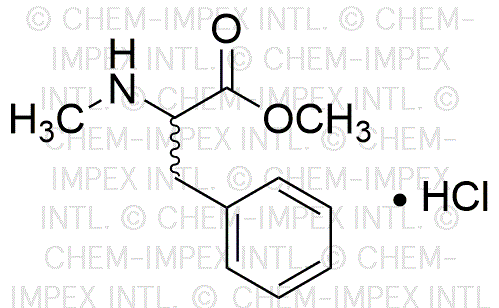N-Methyl-DL-phenylalanine methyl ester hydrochloride is widely utilized in research focused on:
- Pharmaceutical Development: This compound serves as a building block in the synthesis of various pharmaceuticals, particularly those targeting neurological disorders, enhancing drug efficacy and specificity.
- Biochemical Research: It is employed in studies involving neurotransmitter systems, helping researchers understand the role of amino acids in brain function and behavior.
- Protein Engineering: The compound can be used to modify proteins, allowing scientists to explore structure-function relationships and improve enzyme activity in industrial applications.
- Analytical Chemistry: It acts as a standard in chromatographic techniques, aiding in the accurate quantification of amino acids in complex biological samples.
- Food Industry: This chemical can be utilized as a flavor enhancer or additive, contributing to the development of new food products with improved taste profiles.
General Information
Properties
Safety and Regulations
Applications
N-Methyl-DL-phenylalanine methyl ester hydrochloride is widely utilized in research focused on:
- Pharmaceutical Development: This compound serves as a building block in the synthesis of various pharmaceuticals, particularly those targeting neurological disorders, enhancing drug efficacy and specificity.
- Biochemical Research: It is employed in studies involving neurotransmitter systems, helping researchers understand the role of amino acids in brain function and behavior.
- Protein Engineering: The compound can be used to modify proteins, allowing scientists to explore structure-function relationships and improve enzyme activity in industrial applications.
- Analytical Chemistry: It acts as a standard in chromatographic techniques, aiding in the accurate quantification of amino acids in complex biological samples.
- Food Industry: This chemical can be utilized as a flavor enhancer or additive, contributing to the development of new food products with improved taste profiles.
Documents
Safety Data Sheets (SDS)
The SDS provides comprehensive safety information on handling, storage, and disposal of the product.
Product Specification (PS)
The PS provides a comprehensive breakdown of the product’s properties, including chemical composition, physical state, purity, and storage requirements. It also details acceptable quality ranges and the product's intended applications.
Certificates of Analysis (COA)
Search for Certificates of Analysis (COA) by entering the products Lot Number. Lot and Batch Numbers can be found on a product’s label following the words ‘Lot’ or ‘Batch’.
Numéro de catalogue
Numéro de lot/série
Certificates Of Origin (COO)
This COO confirms the country where the product was manufactured, and also details the materials and components used in it and whether it is derived from natural, synthetic, or other specific sources. This certificate may be required for customs, trade, and regulatory compliance.
Numéro de catalogue
Numéro de lot/série
Safety Data Sheets (SDS)
The SDS provides comprehensive safety information on handling, storage, and disposal of the product.
DownloadProduct Specification (PS)
The PS provides a comprehensive breakdown of the product’s properties, including chemical composition, physical state, purity, and storage requirements. It also details acceptable quality ranges and the product's intended applications.
DownloadCertificates of Analysis (COA)
Search for Certificates of Analysis (COA) by entering the products Lot Number. Lot and Batch Numbers can be found on a product’s label following the words ‘Lot’ or ‘Batch’.
Numéro de catalogue
Numéro de lot/série
Certificates Of Origin (COO)
This COO confirms the country where the product was manufactured, and also details the materials and components used in it and whether it is derived from natural, synthetic, or other specific sources. This certificate may be required for customs, trade, and regulatory compliance.


